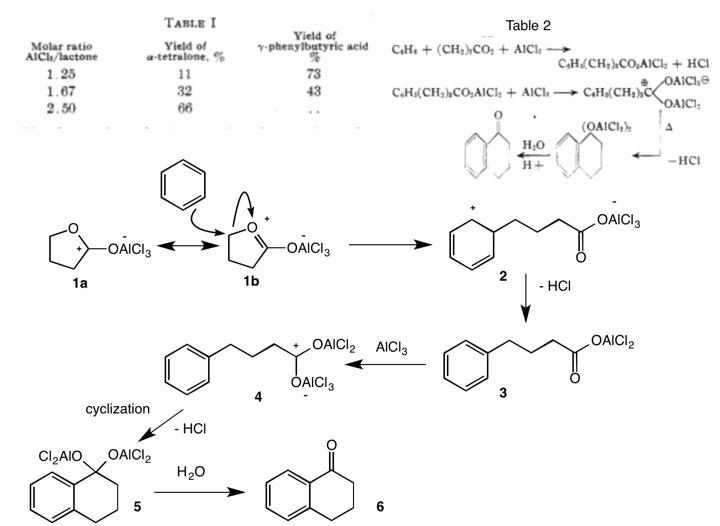Can anyone propose/draw a mechanism for Method A, below, from this paper? Almost all other literature use method B and reagents such as SOCl2.

-
2$\begingroup$ Welcome to ChemSE; Unless you offer a solution to this question it will be voted down. We do not do homework but we will help you with some effort on your part. Get back to us. $\endgroup$– user55119Commented Aug 7, 2019 at 20:46
-
1$\begingroup$ What is the role of AlCl3? What is its reactivity? How about the lactone? $\endgroup$– RaphaëlCommented Aug 7, 2019 at 21:10
-
1$\begingroup$ My best shot is: the ring breaks in order to stabilize the activated oxygen. I am unsure whether it is at the 2 or 4 carbon... I am then unsure as to whether there is a hydride shift, whether an acylium or carboxylic acid group forms, how to remove the hydroxyl group, and how the benzene attacks... $\endgroup$– JBGCommented Aug 7, 2019 at 22:05
-
2$\begingroup$ Additionally I have found several papers that show that this reaction does not proceed eg reader.elsevier.com/reader/sd/pii/… $\endgroup$– JBGCommented Aug 7, 2019 at 22:06
-
1$\begingroup$ @JBG you can include all the information of yours in the comments into your question to make it more contextual rather than a mere homework question. $\endgroup$– Nilay GhoshCommented Aug 8, 2019 at 4:47
1 Answer
The reaction of benzene and γ-butyrolactone with AlCl3 was reported by Truce and Olson1 in 1952. The authors found that the ratio of γ-phenylbutyric acid to α-tetralone was dependent on the AlCl3/lactone ratio. The larger the latter ratio; the more α-tetralone. (See Table 1 from the paper). The ratio employed in the Organic Syntheses preparation is 3.7. Table 2 from Truce's paper provides an explanation for the role of excess AlCl3 but it doesn't explain the alkylation of benzene.
The lactone-AlCl3 complex 1 can act as an electrophile aromatic alkylation (1-->2-->3). Subsequent intramolecular acylation of 4 leads to α-tetralone 6. Bear in mind that γ-butyrolactone reacts with HBr to form γ-bromobutyric acid.
1) W. E. Truce and C. E. Olson, J. Am. Chem. Soc., 1952, 74, 4721.

